Raise your hand if you’d want to make more passive income! I know I do! That’s why I use display ads to monetize my blog traffic.
But how can you make sure you’re not leaving money on the table with display ads? Is there a quick way to increase increase display ad income easily?
I don’t know about you but I don’t have the time (nor the skills) to keep up with everything that’s happening in the realm of display advertising. I need solutions that are easy to implement and monitor. And they need to work!
Luckily, there are several ways to boost your RPM with your current display ad network. And although a few of them require some work, there’s no need to overcomplicate things.
In this post, I’ll reveal 15 simple techniques you can use right now to increase display ad income on your blog today. They’re all tested and proven effective by yours truly! They’ll help you squeeze out every dime from your display ads without making your ads intrusive.
Ready to get started? Let’s dive right in!
Here are a few relevant posts you may want to read, too:
- How to Monetize Your Blog? 5 Surefire Ways to Make Money Blogging
- 10+ Best Ad Networks for Bloggers This Year
Disclosure: This page contains affiliate links, meaning I receive a commission if you decide to purchase using my links, but at no additional cost to you. Please read my disclosure for more information.
1: Add more white space
I’m a huge fan of anything that makes my blogs more readable. Using shorter paragraphs, lists, and headings makes your articles scannable.
Because the truth is: if your readers can’t scan your articles easily, they’ll be gone and so will your ad revenue.
So how is white space related to ad income?
Here’s the deal:
If you’re using in-article ads, they are displayed between your paragraphs, headings, and other elements in your blog post.
That said, you can boost your ad income by creating more white space within your article. When your ads have more spots to appear in, your ad network can optimize their positioning better.
Ka-ching!
2: Use different ad units
Should you use standard text ads, display ads, or contextual ads?
The answer is:
All of them!
Publishers and bloggers often assume they know which ad types work best for their readers. But the thing is: you can’t know for sure if you don’t try different things, right?
That being said, you want to experiment with your ads–a lot. Don’t be afraid to run tests on ad units you’d never think of. See how they perform against your normal units and see which ones work the best.
Trust me, you might be surprised about what works best for your blog!
3: Adjust the number of ad units per page
To grow your display ad income, you want to use every chance you have to get an ad in front of your readers’ eyes. Every ad impression counts as a potential click, right?
At the same time, though, I know you don’t want to overwhelm your reader with dozens of different ads per page. Ads can often make blogs look cluttered and popup ads are intrusive and annoying.
If your visitor sees 6 banners, 3 popups, 1 push notification, and an interstitial, they’re not likely to click on any of them.
Also, tons of ads will slow down your page load speed. That’s a no-go for good SEO.
But the thing is:
Using different types and sizes of ads makes them less intrusive and more interesting. Just make sure you don’t overwhelm your readers with too many units.
For example, try complementing your banners with smaller in-article ad units. Also, you might want to experiment with taller ads in your sidebar. Those are usually some of the best-performing ones on my blogs.
If you sign up with a managed ad network like Monumetric, they’ll help you build a solid ad strategy to maximize your revenue. They have tons of experience with different ad units, of course. Thus, try to soak up all their tips to increase display ad income on your blog easily.
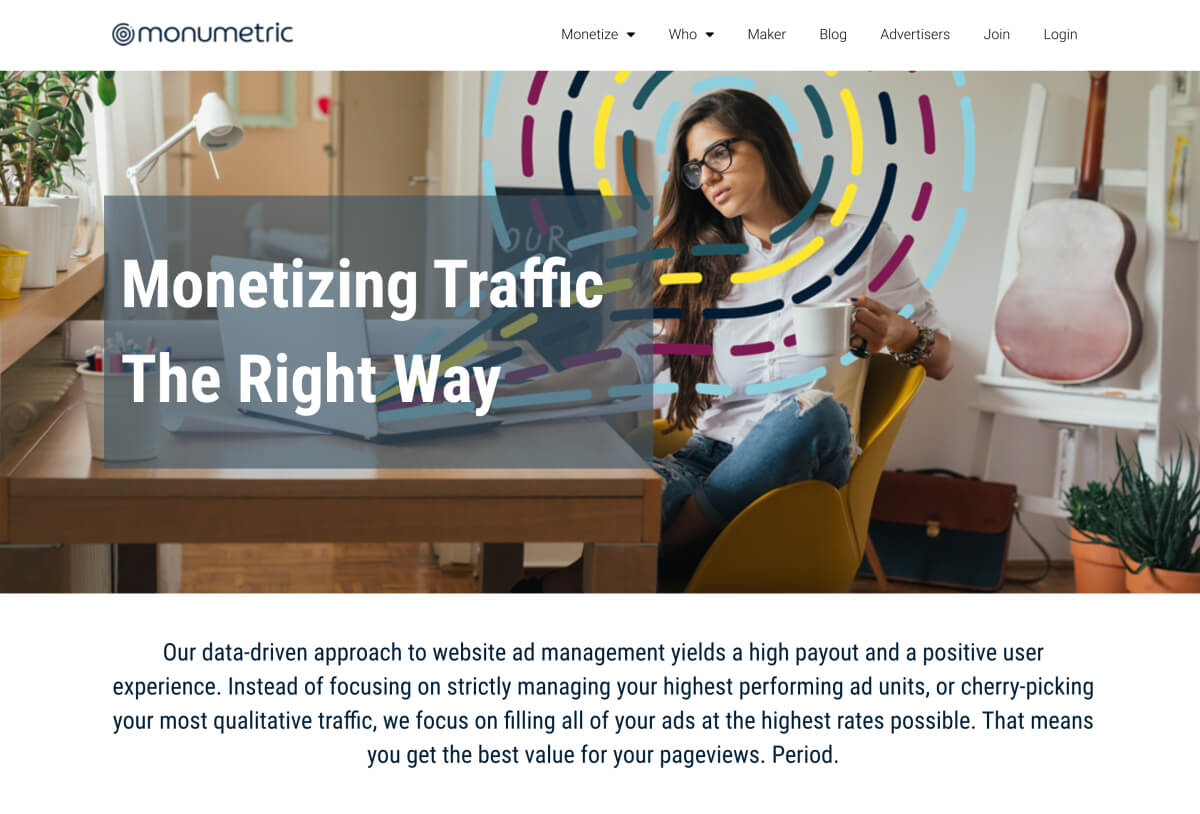
4: Use smart placement tactics
If you’re new to display ads, it’s difficult to know where to place your ads.
Should you use wide banners, rectangles, or taller units?
Although your blog is unique and your readers respond to display ads differently than mine, there are a few general guidelines you can follow.
Here are a few of the highest-performing display ad positions:
- Top-of-the-page banner (leaderboard)
- Sticky bottom banner
- Top of your sidebar
- First in-article ad (after 2-3 first short paragraphs)
Try these out and let me know if it works in the comments section!
The trick is to test a few combinations and see what works best for your blog. If you’re using a managed ad network, they’ll help you come up with a solid ad strategy.
5: Combine different ad networks
Even if your blog is brand new, you might want to experiment with a combination of two (or more) ad networks.
Why?
Because using a single network means you’re putting all your eggs in one basket.
They’re 100% in charge of your ad units, meaning you’re also 100% dependent on their advertisers.
If they can’t serve relevant ads to your readers, you’ll lose valuable ad impressions and potential clicks.
Moreover, not all networks support all the ad types you’d like to use. For example, not all networks offer in-article or video ads.
To get started, check out these best AdSense alternatives for bloggers.
Tip: Always make sure you check with your current network if it’s OK to use several ad partners. Some managed ad networks don’t allow you to cooperate with others as long as their ads are running on your blog. Just something to keep in mind.
6: Compare different display ad networks
This one’s pretty self-explanatory but still worth mentioning:
Different ad networks use different payout models. You want to strike a balance between:
- Reliable support and
- Fair revenue share
What this means is:
If you’re not too keen on the technical part of implementing and adjusting your ads, you should choose a managed display ad network like Monumetric or Mediavine. They’ll take care of everything for you while you focus on tasks you enjoy working with.
Now, this extra support and help doesn’t come for free. After all, the network must pay its employees, too.
Thus, if you choose a managed network, make sure you check their payout terms.
What’s your share of the total ad revenue?
I’ve had a great experience working with Monumetric, for example. They’ve taught me heaps about how I can optimize my ads and increase my income.
But at the same time, my share of the total ad revenue is still almost the same as with AdSense. And I couldn’t be happier about it!
After all, with AdSense, I was never able to reach an actual human being with my questions while working with them. I was doing all the work while they were making money on autopilot. Not cool.
7: Think about seasonality
The truth is: your blog display ad income depends on how much advertisers can spend on ads. That’s just how the market work.
For example, if your blog is about health or weight-loss, you’ll see a spike in traffic and ad income after Christmas.
Or if you write about garden care and tips, you’ll see more traffic and ad income during spring, of course. Here’s the search volume cycle from Google Trends for “gardening”:
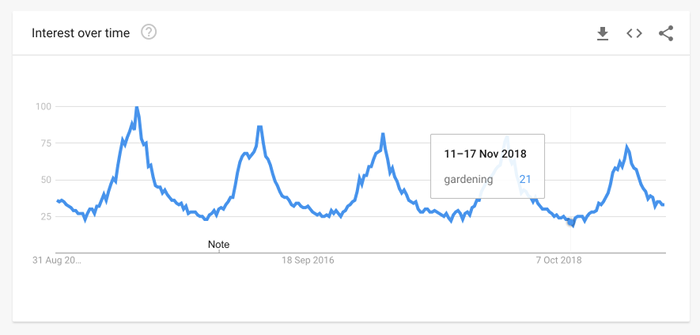
The highest peaks come in April and May, while November and December have about 1/5 of that volume.
Seasonality can boost your ad revenue only if you produce the right type of content for your readers.
Therefore, make sure you attract tons of traffic during the peak season to your blog. That’s when people are buying stuff they need to achieve their goals–whether it’s losing 10 lbs or making sure the garden looks beautiful throughout the summer.
In general, ad revenue tends to increase in November, December, and March. But again, this depends on your blog niche.
8: Write longer blog posts
Needless to say, in-article ads need good content to perform well. When you place your ad units in between your paragraphs and headings, you can increase your ad impressions quickly and easily.
So, the longer your articles are, the more spots you can find for your in-article ads.
For example, let’s say your articles are 1,000 words long and you insert an ad every 250 words. That’s four ad units per post. Not bad!
But think about posts with 2,000 words. Instead of just four, you could place eight in-article ads and double your impressions.
Of course, you shouldn’t aim for longer articles just to boost your ad impressions.
Make sure your long-form posts have tons of valuable information for your readers. Check out these smart tips for writing the perfect blog post.
Also, double-check the guidelines of your current ad network to see how many ads you can display per page. You don’t want to exceed their limit just to be kicked from their program.
9: Make your blog sticky
What the heck is a sticky blog?
Sounds weird, I know, but the idea is simple:
You want your readers to stay on your blog longer.
The longer they keep reading your articles and navigate from one to the other, the more ads you can show then, right?
And those ad impressions turn into more clicks and more ad income for you.
So how do you create a sticky blog, then?
Let’s look at a few easy tricks:
- Write engaging posts worth reading:
Offer your readers value, help them with their issues, and solve their problems. You want them to consume tons of your content, so catch their attention with powerful blog post titles and stellar introductions! - Make navigation easy:
The moment your readers can’t find their way through your blog, they’ll hit the “Back” button. Avoid cluttering your menu and place helpful shortcuts in your sidebar if you’re using one. - Keep your articles focused on a single topic:
Try to answer a single question per blog post. You can still write long-form posts, don’t worry. Just don’t be all over the place. Focus on one problem in a post and add links to related, relevant posts to answer the next questions your readers have. - Break up your text with white space:
Make your articles as easy to read as possible. Keep them structured and logical, so that your readers can follow them like a story. Add headings, keep your paragraphs short, use images and lists generously.
To track how you’re posts are performing, head over to Google Analytics.
You want to monitor the average time your reader spends on your blog. Track metrics like “Average time on page” or “Average session duration”:
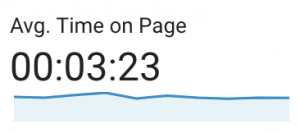
10: Check your writing and grammar
Have you ever read an article packed with spelling mistakes and typos? How did you react?
I doubt you stayed on that blog for long. And I’m not blaming you–I’d click the Back button asap, too!
Spelling and grammar mistakes make blog posts difficult to read and follow. Especially with long-form posts, it’s hard to understand the message the writer wants to convey. If you’re constantly taking breaks to decipher typos, you won’t spend much time reading the content.
Improving your grammar and spelling will make your articles much more pleasant to read. You text flows more easily, making your readers spend more time on your blog.
And hey, that’s going to mean more ad impressions and clicks for you–yet again! Hooray!
Now, the thing is, English doesn’t even have to be your first language.
I mean, I speak Finnish as my mother tongue! But I still run a few blogs, some of them including tons of technical writing. I know my English isn’t perfect–but as long as I get my message through, I’m happy.
And I have a special weapon up my sleeve, too…
How to proofread and polish your language easily:
The easiest way to fix your spelling and grammar is to use a tool like Grammarly. I use it for every bit of writing I do in English, even some of my emails.

The free version is perfect to get started. But if you write a lot, the premium version unlocks even more powerful tools to get your writing on par with your competition.
11: Switch to a PPV ad network
Most ad networks work on a pay-per-click (PPC) basis. This means you only earn income when someone clicks on an ad on your blog.
Broadly speaking, you’ll need a good amount of traffic to generate a good level of passive income with PPC ads. Also, your income will fluctuate a lot, even if your traffic stays constant.
If you want to make more money, you should sign up with a pay-per-view (PPV) ad network. PPV ads mean you earn passive income whenever someone views your ads. So, even if nobody clicks on them, you’ll still earn something.
These are some of the best PPV ad networks you can join:
- Monumetric – Minimum traffic: 10,000 monthly pageviews
- Mediavine – Minimum traffic: 25,000 monthly sessions
- AdThrive – Minimum traffic: 100,000 monthly pageviews
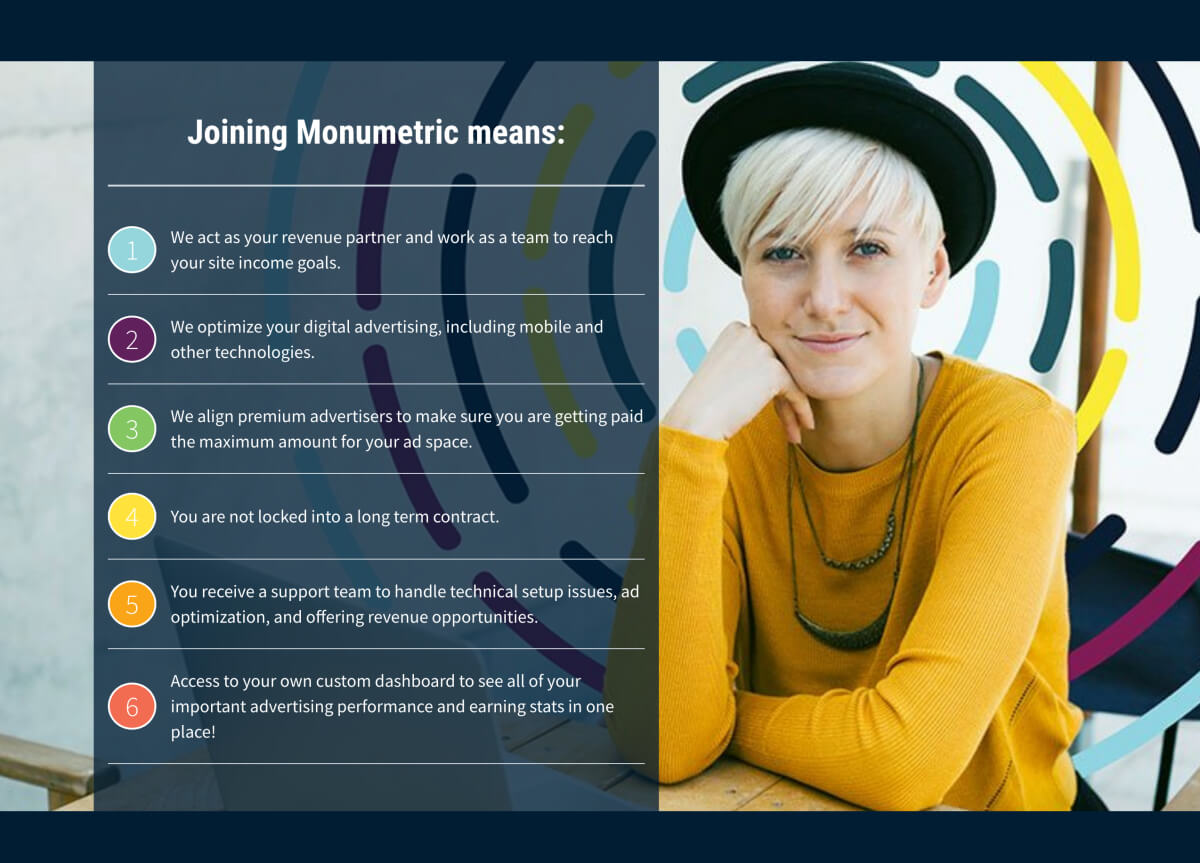
PPV ads usually generate a more steady income flow, since you don’t have to wait for those clicks. As long as your traffic is constant, so is your ad revenue.
This brings us to our next point…
12: Grow your blog traffic
Blog traffic…
I want it, you want it, everyone wants it!
Because the more people are reading your blog, the higher your chances for clicks and impressions will be.
Whether you’re using a PPV or PPC ad network, you can easily increase display ad income as you gain more readers.
Hence, blog traffic is the most important factor when it comes to growing your display ad income. Zero readers, zero ad revenue, right?
And more importantly: some of the best-paying ad networks have a minimum traffic requirement. To join them, your blog needs to attract a given number of pageviews or sessions per month.
Now, these managed ad networks are among the highest-paying ones. When I switched from AdSense to Monumetric, my ad revenue increased up to 10-fold–I’m not kidding!
Check out my post about my Monumetric earnings for all the details!
To learn how to increase your pageviews, check out these 7 powerful tools to grow your blog traffic quickly.
How you can increase your traffic easily:
Even if you’re just getting started with blogging, you can boost your traffic quite quickly.
Of course, you should keep creating stellar content regularly, but you also want to leverage your search engine and social media traffic as early on as possible.
It’s essential to learn what Search Engine Optimization or SEO is and how you can use simple SEO techniques to generate free, organic traffic to your blog.
But although I love SEO and learning more about it, the results are too slow when my blogs are brand new.
So, I always turn to Pinterest. It’s an easy-to-use platform for sharing your blog posts with the world. The more you pin, the more potential readers you’ll reach.
If you haven’t tried Pinterest yet, head over to my free Pinterest traffic strategy guide to learn all you need to know right now!
Although Pinterest is easy to use and you will see results fast, it can take a lot of time to stay active on the platform.
Pinterest recommends we share new, fresh pins daily, but I don’t have time for pinning manually every day!
I see some bloggers pinning up to 150 times daily – that’s heaps!
Luckily, there are several powerful tools that help you save time and pin more in less time.
I use an automation tool called Tailwind. It automatically finds the best time slots for me to schedule my pins. Thus, I don’t have to worry about pinning when all my readers are asleep, for instance.
Here’s what happened to my blog traffic when I started using Tailwind:

I was struggling to get 500 daily pageviews before Pinterest and Tailwind. But once I started using them, my traffic doubled in about 30 days!
If you’re not familiar, make sure you give Tailwind a try for free here.
13: Monitor your ad performance regularly
I was one of them.
One of the publishers who were only checking their ad network dashboard to see how much money they’re making.
BIG mistake!
The next time you log in to your dashboard, have a look around. It’s most likely packed with useful features like reporting tools to help you increase your ad revenue.
For instance, you can often find metrics for different ad types, units, and sizes. See which ones are working best. What units get the most clicks?
My Monumetric dashboard has a super nifty overview of where my ad income comes from. Here’s a report showing the traffic-to-revenue relationship for each device separately:
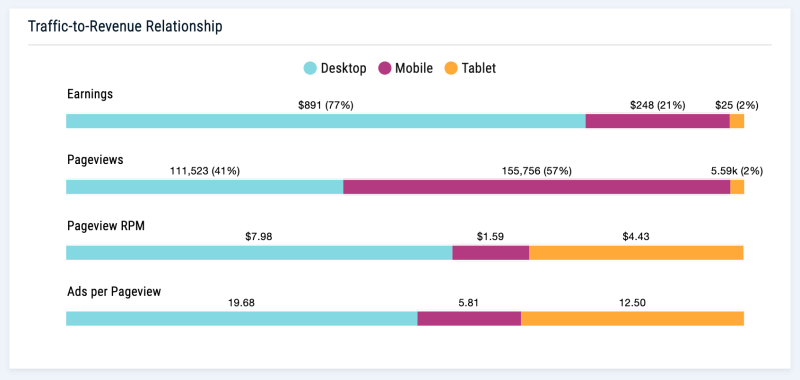
I can see right away that there’s a lot of potential to increase my ad revenue for mobile devices. They count for 57% of my traffic but just 21% of my ad revenue.
Thus, I should look for ways to increase the number of ad units shown to mobile visitors.
Also, when you change your blog layout and design, make sure you check your reports.
Most often, you’ll see a direct effect on your ad revenue. Thus, the next time you’re thinking about a blog redesign, why not build dedicated spots and optimal placements for your ads, too?
Tip: Whenever you adjust your ad units, let them run for a while before readjusting. Don’t draw conclusions based on a week’s performance or you could be hurting your ad revenue. Just have patience here.
14: Focus on getting new visitors
Think about a website you visit often. You’re familiar with their layout and your eye immediately finds the links you’re looking for. Most probably you’re not paying any attention their ads, right?
One of the easiest ways to increase display ad income is to get new visitors to read your blog. They’re not familiar with your ad placements and units. They haven’t seen your ads yet.
You can check the number of new and returning visitors in Google Analytics. Navigate to Behavior > Site Content > All Pages and then add the secondary dimension Users > User Type:

This will show you an overview of which pages on your blog attract the highest and the lowest shares of new visitors.
If some pages are high in returning visitors, it might be time for some quick SEO measures to boost new traffic.
15: Manage your ad units with a WordPress plugin
Implementing and managing your different ad units can eat up a lot of your time. And I know you already have heaps of things on your plate–your blog is your business, after all!
To help you save time and manage your ad units more easily, try the Ad Inserter plugin. It’s free to use–I’ve never needed the paid version so far.
When you’ve installed the plugin, you can find the settings in your WordPress dashboard under Settings > Ad Inserter.
And although the interface may look a bit technical, the plugin is super easy to use.
Here’s what you need to do:
- Get your ad code snippet
Head over to your ad network. Create an ad unit you’d like to use and you’ll get your ad code snippet right away. You need to embed it into your blog to start showing ads to your readers. - Paste the snippet into the plugin
Copy and paste the ad script or snippet into the plugin. - Choose your ad placement
Next, you need to choose the placement for that ad unit. Choose the pages and post you want to embed your ad onto.
For more details, check out their Quick Start Guide.
Once you get a hang of how the plugin works, it makes managing your ads much easier. Especially if you want to embed ads into your post content, the plugin is a real time-saver.
Final thoughts: How to increase display ad income on your blog
There ya go! I’m sure these tips can help you increase display ad income for your blog. Just start with one and work your way through the list!
Please share this post with others, too!
The bottom line is: variety and experiments are key to success. If you want to boost your display ad income easily, don’t be afraid to test different ads and networks. Just make sure you always monitor the results and adjust your ads accordingly.
If you’re looking for a network to join, I’d recommend giving Monumetric a try. They’ve quickly become my highest-earning ad partner on one of my niche blogs. Check out my Monumetric review for more details.
In case you don’t fulfill their minimum traffic requirement, use these powerful tools to grow your blog traffic fast.
And in the meantime, you may want to team up with these best display ad networks for small publishers.
Now, what’s your plan to make money with ads on your blog? I want to hear your thoughts!
Here are a few related articles you may want to read, too:
- How to Treat Your Blog Like a Business? 7 Smart Tips for Beginners
- The Best Mediavine Alternative for Bloggers (That Pays Well)


